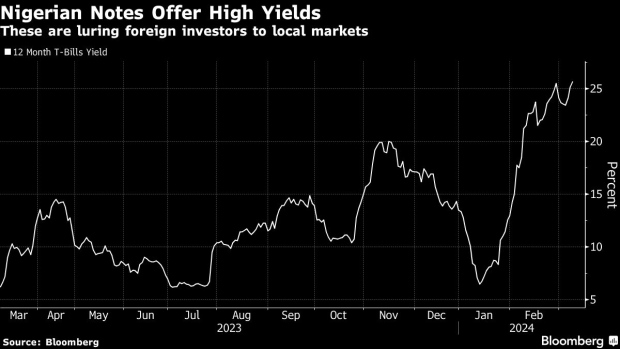Frontier markets win over bond investors with ‘radical shift’
Frontier markets have embarked on aggressive policy shifts, and investors in local-currency bonds are starting to reap the benefits.
Central banks across key frontier economies including Kenya, Nigeria and Egypt have hiked policy rates significantly in recent months, while also implementing steps to liberalize markets — such as Nigeria’s move to allow free trading in the naira.
Those measures, aimed at curbing the tide of inflation brought about in part by depreciating currencies, signal a growing commitment to financial orthodoxy and stability. Some money managers are already positioning their portfolios to take advantage of falling yields and strengthening currencies that may be the result.
“Frontier in recent years has offered the horrible combination of negative real rates and overvalued currencies,” said Charlie Robertson, head of macro strategy at FIM Partners. “Now we have cheap currencies and in some cases, the highest real interest rates in the world. It’s been a radical shift.
Demand for local-currency bonds in Kenya and Egypt has surged since the nations increased benchmark interest rates, Robertson said. Nigeria may see similar interest once its central bank completes its rate hike cycle, he said.
Ex-ante real rates in frontier markets — the difference between the nominal yields and the expected inflation rate — have moved further into positive territory, according to calculations by Goldman Sachs Group Inc. That should give those markets a growing yield advantage as major developed markets move to reduce rates.
“There are definitely opportunities in frontier markets,” said Peter Marber, chief investment officer for emerging markets at Aperture Investors based in New York. Currency devaluations and high yields in countries like Egypt, Nigeria, Argentina, and Turkey — which to some investors displays frontier characteristics — make those local bond markets attractive, he said.
In addition, some low-rated sovereigns offer US dollar spreads of as much as 1,000 basis points, which have room for compression as US interest rates begin to fall this year, Marber said.
Policy U-turns
Bets on frontier markets can be tricky considering a record of policy u-turns from Nigeria to Zimbabwe.
“These countries need to remove capital restrictions, remove the multiplicity of exchange rates, and provide positive real interest rates to attract international investments,” said Bloomberg’s chief emerging-market economist Ziad Daoud. “They also need to learn from their recent experience by not over-relying on hot money inflows.”
That’s what Nigeria seems to be doing. A series of measures by policymakers aimed at liberalizing the currency market and attracting capital have resulted in a jump in remittances and foreign-investor portfolio asset purchases. Then last month the central bank announced a jumbo rate increase to tackle runaway inflation and stem the collapse in the naira, the world’s worst-performing currency this year.
The result: The naira has stabilized around 1,600 per dollar, while also closing the gap with the street-market rate. And real rates have turned positive on an ex-ante basis, even though the ex-post real rate — based on the current inflation rate — is still deeply negative.
“Given a combination of positive real rates, capital inflows, and evidence of a shift to a more orthodox policy set-up, we think that Nigeria is turning the corner following its recent currency crisis,” said Goldman Sachs analyst Andrew Matheny.
Goldman Sachs expects the naira to strengthen to 1,200 per US dollar in 12 months, a gain of about 25%. The lender also sees the country’s dollar bonds as attractive, with foreign-exchange reserves of $34.37 billion at the highest since June last year, according to central bank data.
Egypt has a similar story. After securing funding from United Arab Emirates, the country’s central bank delivered a long-awaited currency devaluation and a record rate hike of 600 basis points last week. Moreover, it introduced a flexible currency regime, abandoning the pound’s dollar peg.
Kenya has also made a remarkable turnaround. In January, Kenya’s shilling was the third-worst performer globally, plumbing a record low versus the dollar. Since then, it has rebounded more than 20%, aided by tighter monetary policy, International Monetary Fund funding and a new Eurobond issue.
Barclays Plc recommends buying both Egypt’s and Nigeria’s dollar bonds, saying recent developments and reform momentum could ultimately result in rating upgrades. “Markets are taking note and are rewarding positive idiosyncratic developments with outperformance,” strategists led by Christian Keller wrote in note.
Deutsche Bank, on the other hand, favors Egypt’s local debt. “Despite the slightly rich valuation in our static fair value model, longer T-bills and short-end bonds offer attractive yield levels from a structural perspective and most importantly an attractive pickup over NDFs,” strategists led by Christian Wietoska wrote in note.
It’s not only African frontier markets that are attracting attention. Bank of America Corp. sees opportunities in external debt of Pakistan and Sri Lanka, among others. In Latin America, Bank of America recommends buying Guatemala’s 2050 bonds, which carry a significant political risk premium which could reverse following the inauguration of Bernardo Arevalo as president.
“With high uncertainty about the inflation, growth, and US rates outlook, we believe investors should remain selective and focus on relative value opportunities in LatAm,” Bank of America strategists Christian Gonzalez Rojas and Ezequiel Aguirre wrote in a note.








